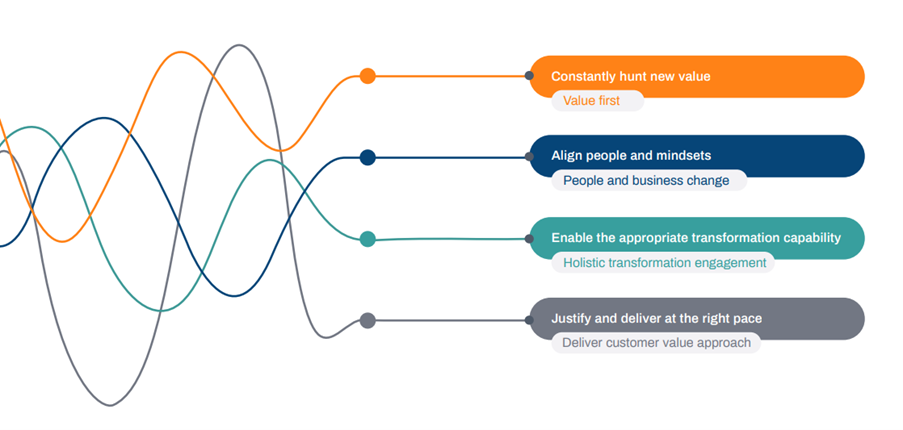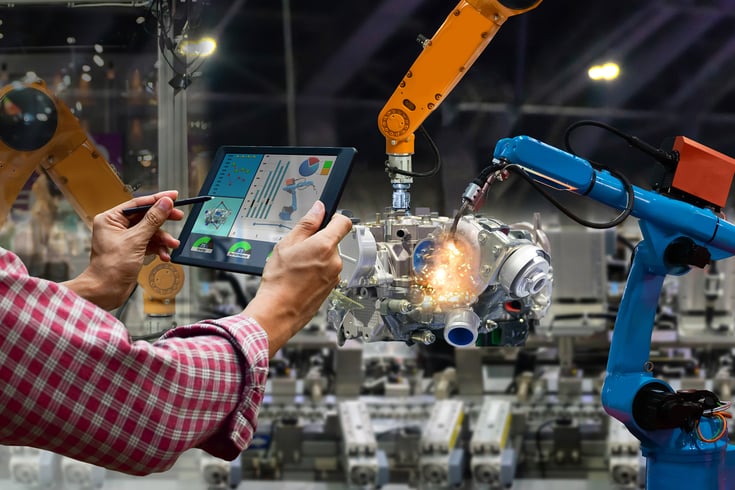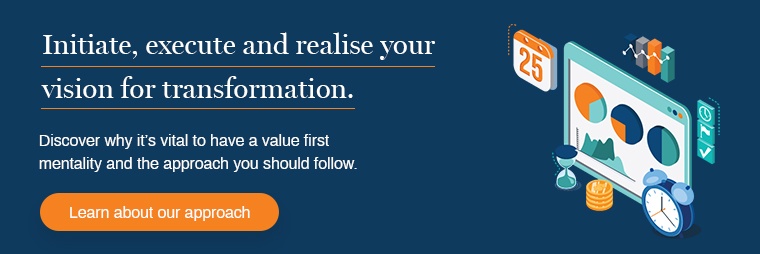With new innovations always on the horizon, manufacturers are amongst the businesses most susceptible to change. This was highlighted in a recent report from The Manufacturer, which found 63% of manufacturers say they’re focusing on increasing manufacturing agility over the next 12-24 months.
However, many manufacturers struggle with business and digital transformation, with a third of manufacturers (33%) saying their ability to manage change is one of the main obstacles to achieving their business goals over the next 12-24 months. On top of this, statistics show that only 30% of transformations achieve the outcomes and deliver the value they were looking for. 70% fall short.
A common theme for those who succeed is consistently clarifying the outcomes and value they expect to generate. Then, pair this with a holistic approach with the people's side (of transformation) at the centre, not the technology.
To achieve new value, you must concurrently deploy the right digital technologies and be strong in many of the disciplines that lead to successful business transformation.
The wildcard in digital transformation is people
People and their motivations are often the root cause of failure. This is because change usually means a new process, technique or system your employees must learn, which can cause disruption, confusion and even fear. By putting value first (which includes addressing the “what’s in it for me?” question), you can increase the chances of buy-in and transformation success.

Putting value into context
Value can come in several forms and be a financial or non-financial gain. For example, one group of stakeholders in your organisation might see value as increasing revenue, while another might see value as improving specific business processes. Essentially, value is any improvement perceived as beneficial for your internal and external stakeholders.
Value First with a people mindset
When we know the wildcard in digital transformation is people, we can put value into context across all stakeholder groups (people impacted and involved), and help stakeholders see “what's in it for me”. This allows us to create alignment, priorities and a pull by the stakeholders in making the changes and adopting the solutions.
This is what our Value First modern and adaptable approach helps deliver, along with many other enablers for success in business and digital transformation.
Follow our value first customer approach to defeat the odds
What can be controlled in a quickly changing digital world, where digital transformation is growing increasingly complex, and the desired outcomes are often not achieved? To succeed, focus on the following intertwined activities, starting with value first…
 Constantly hunt new value
Constantly hunt new value
Ensure all business and solution designs and transformations are value-driven from the outset (envisioning stage), throughout and post-transition, by establishing opportunities for further improvement and the evolution of the value. As we mentioned earlier, value doesn’t just mean financial benefits; it’s all the improvements perceived as beneficial by internal and external stakeholders.

We recommend using a design thinking approach to identify and hunt new value. New value is something you don't currently have, so you might be able to increase value in areas of the business where you already create that type of value. For example, increased revenue of an existing product line. Whereas new value is all about finding value in areas you currently don't enable value today. For example, making it easier for a customer to do business with you where it currently isn’t easy.
Align people and mindsets
Aligning and guiding people starts at the top! Empower your people with approaches and toolsets that enlighten them, a bold and engaging vision, and effective stakeholder management and communications. Always put the leading and managing of people through change at the heart of any digital transformation.
However, this isn’t standard business and people change management – it's more than that. This is about aligning people before starting the initiative that'll enable new value and transform your organisation. This is about aligning people on the outcomes and what's important to them, to their colleagues, customers and suppliers, overall in their business and ideally across their supply chain and industry – across all stakeholder groups.
This takes a different approach in looking at the value, an approach that enables people to work together on:
- What’s required and what's important
- Understanding each other’s point of view
- What can be gained quickly and what's going to take a bit longer
.jpeg?width=6000&height=4004&name=photo-of-people-doing-handshakes-3183197%20(1).jpeg)
This allows you to work through a process to drive the right priorities and alignment on the outcomes required across stakeholder groups.
Enable the appropriate transformation capabilities
Recognise, introduce, and/or continuously develop the enabling disciplines and abilities required to deliver and sustain business and digital transformation. Resolve those capabilities in running the company that may hinder change, keeping it efficient and straightforward yet effective.
It typically takes a different type of skill to change the organisation than it does to run the organisation. By that, we mean the difference in capabilities to enable and lead change over and above the day-to-day management of people and processes.

Justify and deliver at the right pace
Learn, justify and deliver with the right approach and speed for your business and circumstances. Your approach may vary for different elements of the transformational journey (e.g. Portfolio, Programme, and Project investment appraisal and sign-off intervals, waterfall or agile delivery, adopt don’t adapt, explore or exploit utilising modern measures, such as Objectives & Key Results (OKRs) approach.
Tackle change and transformation the right way
By putting the right set of stakeholders together, you can:
- Hunt value together
- Prioritise and align on what success will look like
- Understand the capabilities required to get there and at what pace
This allows you to layer and craft the transformation initiative that will get the entire business pulling on the change, rather than it being pushed upon your manufacturing organisation with little engagement.
No matter where you are on your journey to drive new value, Columbus can guide you on the next step. Value First is just one area of our strategy and change service that’s designed to help you achieve this vision. Learn more about our value first approach by clicking on the button below.

